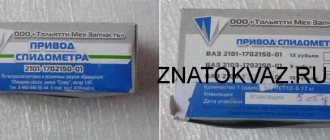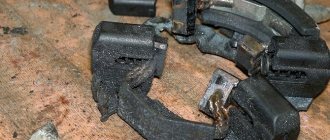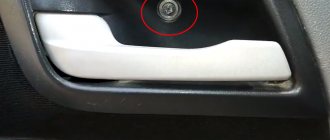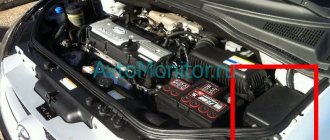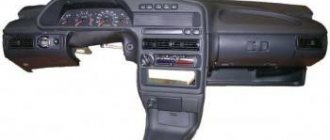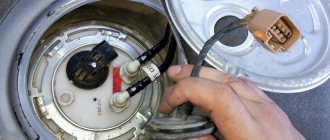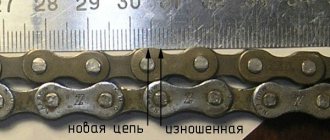Useful tips for installing the speedometer driveAutoRemka
The speedometer drive is necessary in order to show the driver all the data about what speed the car has reached and how far it has traveled. Its breakdown is not catastrophic, but it greatly affects the ease of control.
VAZ models have a mechanical drive, so both gears of the system are mounted on the gearbox shaft. Then the rotating force from them goes through a flexible shaft to the speedometer of the car, which is located on the dashboard. A broken shaft usually causes problems with the speedometer. This means that it is not always possible to change gears successfully due to incorrect speed readings. In addition, there is a risk of getting a fine from the traffic police, because we are sure that we are driving at a speed of 80 km/h, when in fact the broken device is deceiving us. But the traffic police radar will show the true speed of 90 km/h.
To find out that the shaft is really broken, you should simply disconnect it from the speedometer and start the engine. Then you need to drive a couple of tens of meters, observing the end of the shaft. If we notice that the tip is stationary, then we open the hood and take it out. If during extraction only its shell is pulled out, then we can be sure that there is a rupture in the system.
Replacing the VAZ 2107 speedometer cable begins with preparing the necessary tools. You will need several keys (among which must be the 10th and 13th), a lift or an inspection hole. All work, with certain skill and experience, takes no more than 20 minutes. Beginners and those who don’t do repairs very often at all can dig around a little longer.
So, let's move on to removing the clamp bolt. To do this, use a 13mm wrench. After that, we deal with the bolt securing the device drive shaft. Here you will need to use a 10mm wrench. There are also a couple of nuts that secure the cross member to the surface of the body. We unscrew them with a key of 13. Then we slowly lower the rear part of the gearbox down. This must be done so that the studs begin to protrude slightly from the holes in the cross member. Next, we begin to shift the gearbox to the right and remove the speedometer drive located in the crankcase hole. The replacement drive we purchased is installed into the system in the reverse order. In this case, to replace the cable, you just need to disconnect the upper fastening of the cable from the speed reading device and remove it from the hole located on the front panel.
It is useful to know that the speedometer drive is slightly different in different VAZ models. The main difference is the number of teeth on the main gear. The very first type of device is practically “extinct”. It was installed on model 2101, it did not have a mark and had twelve teeth. At the same time, it can still successfully fit a Lada with a gearbox having a gear ratio of 4.3. This drive is also found in models 2102.
Drives with nine teeth are mounted in third VAZ models and are marked with red paint. The gearbox ratio is 4.1.
And finally, the most popular option is a thirteen-tooth drive. It is installed on models 2106 and some others. Marked with blue paint. Moreover, this drive is easily suitable for almost all classic models with axle 2106, which have a gear ratio of 3.9.
The cost of a new speedometer drive is about 300 rubles. Experts recommend not saving on this spare part. After all, not only convenience, but also safety depends on the proper operation of the speedometer drive. What responsible driver would want to constantly see incorrect speed readings and worry about shifting problems?
Speedometer drive VAZ 2101 2115
Where is the speedometer sensor located on the VAZ 2110? Where is the speedometer sensor located?
On cars produced by VAZ, two types of speedometer drives are used - electrical and mechanical. The latter was installed on classic models 2101-2107 and front-wheel drive 2108 - 2115 until the beginning of the first decade of the 21st century, after which they switched to installing an electronic speedometer drive. The basis of the speedometer drive of any type is a plastic gear inserted into the gearbox (gearbox). Its task is to transmit the rotation of the gearbox secondary shaft to an electrical or mechanical speedometer sensor.
How mechanical and electric drives work
While the car is moving, the speedometer drive gear, using a flexible cable, transmits rotation from the secondary shaft to the speed sensor located in the instrument panel. Different drive gears are used on different VAZ car models. This is due to the different transmission ratio of the gearbox (main gear). A higher ratio of differential teeth to drive gear allows the vehicle to reach higher speeds, but has a negative impact on dynamics.
A smaller ratio improves dynamics but limits top speed. In order for the speedometer to accurately display the speed, it is necessary to ensure the correct relationship between the drive gear located on the secondary shaft and the speedometer drive gear. When selecting a speedometer drive, take into account the size of the wheels and the transmission ratio of the vehicle's gearbox. This approach allows you to use a common speedometer for all models of each family.
Unlike a mechanical one, the electric speedometer drive transmits rotation not to the indicator, but to the speed sensor, which converts the gear rotation speed into signals understandable to the electronic control unit. This approach allows you not only to display the speed on the speedometer indicator, but to control the operation of the injector.
Video - How to change the speedometer drive on a classic (2101 – 2107)
To replace the speedometer drive you will need an inspection pit, overpass or lift.
The speedometer drive is located on the left side of the gearbox next to the support (beam). To remove the speedometer drive, unscrew the plastic cable end nut and remove it. After this, remove the tension spring from the clutch slave cylinder. Pull the cotter pin out of the pusher and unscrew the two cylinder mounting bolts and pull the pusher out of the clutch release fork. Lower the box as far as possible and unscrew the speedometer drive bolts, then pull it out of the gearbox.
Before installing a new drive, ensure that the number of teeth matches the gear ratio. 13 teeth for a gearbox with a ratio of 3.9 (speed). 12 teeth for gearbox with ratio 4.1 (standard). 9 teeth for gearbox with ratio 4.3 (traction). When installing a new speedometer drive, use a gasket from a repair kit or automotive sealant. If installing a new speedometer drive does not improve performance (the cable and indicator are in order), you will need to dismantle the gearbox, disassemble and replace the drive gear. Replacing the electric drive is carried out in the same way, the difference is that instead of unscrewing the cable, remove the wire terminal from the contact and unscrew the speed sensor (converter), after which the drive gear is removed.
Replacement on front-wheel drive vehicles
On models 2108 – 2115, the speedometer drive is located on the side of the gearbox on the rear wall of the engine compartment. It is accessible from the hood. The replacement technology is no different from that used on classics - remove the cable end or wire block (to do this, unfasten the latches), remove the speed sensor, unscrew the bolt securing the drive gear and remove it from the gearbox. The ratio of the number of teeth of the drive gear and the drive gear of the secondary shaft does not differ.
Why does the speedometer on the VAZ 2109 not work?
How to make a kenguryatnik for a car with your own hands and legalize the product. Do-it-yourself kenguryatnik on Niva manufacturing and installation
On VAZ-2109 cars the speedometer drive is mechanical. The drive and driven gears are installed on the secondary shaft of the gearbox, from which torque is transmitted via a flexible shaft to the speedometer located on the instrument panel. Considering that VAZ-2109 cars are produced with low and high front panels, the length of the flexible speedometer drive shaft will be different. For VAZ-2109 cars with a low panel, the flexible shaft will be shorter, and for cars with a high panel it will be longer.
The most common reason for a speedometer not working is a break in the flexible shaft, usually near the entrance to the gearbox. In order to check this assumption, you need to get to the instrument panel and disconnect the flexible shaft from the speedometer. Next, start the engine and drive about twenty meters, watching the tip of the flexible shaft. If it does not spin, then you will have to open the hood, unscrew the union nut securing the flexible shaft and pull it out. If the flexible shaft breaks, then only its shell will be pulled out, and its tip will remain in the drive. You can get it out using pliers.
If the flexible shaft is taken out along with the shell, it means that it is intact, but the edges at its very tip have been eaten away, so it cannot transmit torque from the drive gears. In both cases the flex shaft needs to be replaced, but remember that a tall panel requires a longer flex shaft.
In addition to the flexible shaft, the cause of failure may be wear of the drive gears. You will have to change them in pairs, and before you go to the car store for new speedometer drive gears, count the number of teeth on the gears that were there before. For new and old gears, the number of teeth must match, otherwise the speedometer readings will be incorrect, both in terms of speed and mileage.
What to do if the speedometer does not work on a VAZ-2110 with an injector
As you know, devices installed in a car allow you to monitor the situation while driving on the streets and monitor the operation of the engine and all other systems.
Among others, the speedometer occupies a special place. It is located on the dashboard directly above the steering wheel. With its help, the driver finds out at what speed the car is moving. In a situation when the speedometer and the injector installed on the VAZ-2110 do not work properly, the person behind the wheel puts both his own health and the lives of passengers at risk. At the same time, he can easily “earn” a fine from a traffic police officer for speeding too high. Thus, a working speedometer allows you to avoid a considerable amount of trouble.
Checking and replacing the VAZ 2107 speed sensor
While the vehicle is moving, the VAZ 2107 speed sensor (injector) generates speed data sent to the electronic engine control unit. Its breakdown causes injection control errors and leads to a drop in engine power and an increase in fuel consumption. You can check and replace the sensor yourself. To do this, you will need a garage with an inspection hole, a slotted screwdriver, a 22 mm wrench and a multimeter or test lamp.
The principle of operation of the VAZ 2107 speed sensor
The operation of the speed sensor is based on the Hall effect, which describes the occurrence of electrical impulses when a conductor with direct current is placed in a magnetic field. The sensor generates pulses during the rotation of the output shaft of the VAZ 2107 gearbox. During the time the car travels a kilometer, the VAZ 2107 speed sensor generates about 6000 pulses, the frequency of which allows you to determine the current speed.
Where is the VAZ 2107 speed sensor located?
The sensor is mounted on the gearbox in the speedometer cable drive mechanism. To remove and check it, you will have to disconnect the gearbox speedometer cable.
Symptoms of a problem
The main sign of problems in the operation of the sensor is the issuance of the corresponding error code by the on-board computer. Malfunctions may manifest themselves in other signs:
- increased fuel consumption;
- poor engine thrust;
- speedometer not working or working with a large error;
- unstable idle.
Attention! These four symptoms may be caused by problems with other parts of the car.
Causes of sensor malfunction
The design of the sensor is quite reliable. The cause of the breakdown is usually oxidized contacts on the sensor or a break in the wires that go from the sensor to the engine ECU. The contacts should be inspected, if necessary, cleaned and lubricated with “Lithol”. It is better to start searching for broken wires from places close to the plug. There they bend more often and, accordingly, fray and break. At the same time, it is worth checking the grounding of the sensor. The resistance in its network should be about 1 Ohm. If no fault is identified, you need to check the speed sensor itself. To do this you will have to remove it from the car.
How to remove the speed sensor VAZ 2107
To remove the speed sensor, you must perform the following operations:
- install the car above the inspection hole;
- engage the parking brake;
- place wheel chocks under the wheels;
- from the inspection hole, using a slotted screwdriver, unscrew the nut of the speedometer drive cable;
- disconnect the cable from the gearbox;
- loosen the plastic clamp that tightens the wiring harness coming from the speed sensor;
- press the spring clips and disconnect the block from the speed sensor;
- Using a 22mm wrench, unscrew the sensor from the speedometer drive;
- remove the speed sensor.
The VAZ 2107 speed sensor can be checked using a multimeter or “control”. To install the sensor, you must do the above steps in reverse order.
Checking the speed sensor
The easiest way to check the speed sensor is to install a new one in its place. The price of the part is low, so this is the easiest and fastest way to make sure it is working or broken. If you don’t have a new VAZ 2107 speed sensor at hand, you should first check the old one, and then go to the store for a new one. To check the operation of the speed sensor, you will need a small plastic tube with a diameter corresponding to the thickness of the sensor axis, and a voltmeter (multimeter). The check is performed in the following sequence:
- connect a voltmeter to the sensor output that supplies electrical signals and to the vehicle ground;
- put the tube on the sensor axis;
- rotate the tube.
As the tube rotates, the voltage at the sensor output should increase in proportion to the rotation speed. If this does not happen, the VAZ 2107 speed sensor needs to be replaced.
Tip: In a similar way, you can check the speed sensor directly on the car. To do this, you need to hang up one of the drive wheels, connect a voltmeter to the sensor output and ground, and start rotating the wheels. If voltage and pulses appear, the sensor is working.
Instead of a voltmeter, you can use a test lamp. In this case, when checking the functionality, voltage must be applied to the “positive” output of the speed sensor. If the light flashes when you rotate the sensor, the problem is not with the sensor. You will have to check other components and parts of the “seven” that could affect the operation of the engine ECU.
Is replacement always necessary?
The information transmitted by the speed sensor to the ECU is very important; the readings of the instruments discussed above depend on it.
This information also affects the quality of the fuel mixture supplied to the cylinders, the idle speed, the stability of the engine and the amount of fuel consumed. If the sensor malfunctions, the electronic unit will not be able to determine whether the car is moving or stationary. In this case, floating speeds are observed, the engine begins to stall, and fuel consumption will become much higher.
Carrying out a vehicle inspection is available to every car enthusiast. To find a fault, you need to know where exactly it is located in the VAZ-2110. The sensor is located in the engine compartment under the hood, in the engine compartment. Nearby is the exhaust manifold (and on the VAZ-2112 there are 16 valves, it is located in the upper part of the gearbox, fully visible and accessible from the engine compartment).
The wires rub against the commutator and this can cause damage. Sometimes it is sufficient to isolate them and position them so that there is no contact with the collector.
Don’t forget about a broken cable, which can cause a breakdown. If this problem is absent, then you need to look for it in the sensor itself or in its drive.
To successfully replace the VAZ-2110 speed sensor, the speedometer's functionality is first restored.
How to remove the speedometer drive VAZ 2109, 2110, 2107, 2114
Speedometer drive: types and differences
A speedometer is an important element in cars, as well as several other vehicles, as it is necessary to monitor speed in order not to violate traffic rules. But this is not the last function of this device.
All possible speedometers have a high-speed magnetic unit; due to the rotation of the magnets, a flow is formed, it moves through the coil, thereby facilitating the induction of eddy currents. They thereby begin to create more magnetic fields. They interact with each other, the needle of the device moves along the frequency scale, with the help of this the magnet rotates.
All speedometers are divided into three categories.
- Mechanical speedometers.
- Electromechanical speedometers.
- Electronic speedometers.
Mechanical speedometers. In this type of speedometer, the process of speed measurement and indication occurs thanks to a mechanical device. A gear is used as sensors, which is connected to the secondary shaft of the gearbox; this is the speed unit with an arrow indicator and the drum counter. Previously, speedometers were used in the form of a drum and tape. But they stopped using them quite a long time ago.
Electromechanical speedometers. In these devices, speed is measured using various electronic or electromechanical sensors that are connected to the gearbox. The speed is indicated by a milliammeter or the speed unit of a mechanical speedometer, and the distance is indicated by a counting drum, which drives a stepper motor.
Electronic speedometers. This is a development of new electromechanical speedometers; the main difference is the replacement of the odometer - in an electronic device it is completely digital.
How to remove the speedometer drive with your own hands - instructions
VAZ 2110
- We support the anti-rollback shoes of the rear wheel, then we need to jack up the front of the car, and then install it on supports.
- On a model with a cable-driven speedometer, remove the fastening pin and disconnect the cable from the gear drive.
- Unscrew the fastening bolt and remove it together with the heat shield.
- Remove the drive with the gear from the crankcase and remove it from the seal ring.
- The gear can be removed from the gearbox housing; be sure to check the condition of the gear; if defects are detected, it must be replaced.
- If there are signs of wear or damage to the gear, the condition of the gear should be checked.
- To remove the gear, release it from the transmission. Then you need to unscrew the mounting bolt and remove the drive gear housing. Then you should remove the drive gear and remove all the adjusting washers.
VAZ 2107
- Using a “13” wrench, you need to unscrew the bolt of the clamp securing the exhaust pipe of the muffler.
- Take a 10mm wrench and unscrew the drive fastening nut.
- Using a 13mm wrench, unscrew the two nuts securing the cross member.
- Then you need to lower the rear of the transmission.
- The pipe section must be moved to the right and then the speedometer drive must be removed from the crankcase hole.
VAZ 2114
- We unscrew the DS counterclockwise.
- After removing the DS, check the VAZ 2114 speed sensor drive.
- Using a “10” wrench, unscrew the nut and pull it out.
- After removing the drive, you need to check the condition of the ring and, if necessary, replace it.
VAZ 2115
- First you need to remove the pipe with the filter housing from the car.
- Clean the surface of the box with a metal brush around the sensor.
- Then wash off the dirt using a cleaner and wipe the surface.
- We hold the sensor using a 22 key.
- Next, it remains to remove the sensor itself.
Frequent causes of speedometer drive failure
- Long service life - each device has its own service life.
- Something fell on the sensor and damaged its connection.
- The wires have dried out or the contact has simply come loose, which prevents the device from working.
- Complex design features of use, increased amount of humidity and constant contamination of the space under the hood.
- Installing a device of poor quality or purchasing a cheap speed sensor without special qualities and characteristics.
Replacement
The process of replacing a diesel engine is very simple, and even the most uninitiated car owner can cope with it.
- key to 21;
- key to 10;
- crosshead screwdriver.
Execution procedure for VAZ 2110 with drive sensors.
1.Raise the hood, disconnect the “-” terminal on the battery.
2. Determine the location of the sensor. For both old and new models, it is located on the back of the engine at the top of the gearbox.
3.If necessary, use a screwdriver to loosen the corrugation clamp, remove it, and move it aside.
4.Squeezing the antennae on the sensor connector, disconnect
5.Use your hands or using a 21 wrench to unscrew the sensor.
6.Using a 10mm wrench, unscrew the nut securing the DS drive and carefully remove it.
7.If the drive is in order, you can leave the old one, but if it has traces of mechanical stress, we replace it.
8. Having installed the drive, install a new sensor by screwing it clockwise.
9.Connect the connector, connect the corrugation, and the negative terminal.
Changing the electronic sensor
1.De-energize the vehicle's on-board circuit.
2. Using a screwdriver, loosen the corrugation clamp and remove it.
3. Disconnect the wires from the DC by moving the latch.
4.Using a 10mm wrench, unscrew the sensor mounting nut.
5.Remove the old sensor, install the new one, tighten the nut.
7.Connect the ground terminal.
Usually installing a new sensor solves all problems associated with it. The engine begins to operate in normal mode, and the speedometer and odometer show accurate information. If the problem does not disappear after installing a new DS, look for it elsewhere.
Any car is equipped with a system that shows the speed of movement and mileage (distance traveled). It is the speedometer, which is a device for determining instantaneous speed, that makes it possible to find out what the maximum speed of the VAZ 2110 is.
Speed sensors are installed only in fuel-injected cars; where carburetor engines are present, they are not present. This device is responsible for the supply and consumption of fuel, setting the ignition timing, and monitors the quality of the combustible mixture. All data is transmitted to the electronic control unit, which controls the injector.
Causes of breakdowns and repair of the speedometer drive on the VAZ 2109
The main causes of speedometer drive malfunction
The speedometer of the VAZ 2109 model has a mechanical drive. The installation of gears, in particular the drive gear, is carried out on the secondary shaft of the gearbox. The transmission of torque to the speedometer located on the dashboard is ensured by a flexible shaft.
One of the features of this model in the equipment can be either a low or high dashboard, which, in turn, indicates that when purchasing a flexible shaft, you need to make sure that the shaft length is suitable for your car.
A common reason for speedometer failure is due to the breakage of this flexible shaft. Usually, the problem manifests itself in a place closer to the gearbox. How to install this break? First, you need to disconnect the flexible drive from the speedometer. Then start the engine and, while driving at low speed, determine whether the end of the shaft rotates or not.
As a rule, to check the functionality of the shaft, it is enough to drive 20-30 meters. Actually, you need to start the engine and drive several tens of meters, observing the behavior of the end of the shaft. If the end of the shaft is motionless, lift the hood cover and unscrew the nut that holds the shaft. If only the shell of the part gives way, then this means only one thing - the shaft has broken. In this case, it is necessary to remove the remaining shaft end from the drive. For this you will need pliers.
However, there is another reason when both the shaft and the shell fail. This indicates that there are simply no edges at the end of the shaft. Regardless of the reasons for the shaft failure, it should be replaced.
Sometimes the need to replace the drive arises due to wear of paired gears. To solve this problem, you do not need to remove the gearbox. To do this, it is enough to drive the car onto an overpass or inspection hole.
First you need to unscrew the bolt securing the drive housing to the gearbox. After this, remove the housing, then the gears. The latter need to be replaced.
To correctly select the gears suitable for the machine, we simply compare the new ones with the old ones: the number of teeth must match.
If oil is detected on the body, then it is advisable to check the O-ring and, if it is worn or damaged, replace it with a new one. You can wash the drive elements using clean kerosene.
Assembly of the unit is carried out in reverse order.
Symptoms of a malfunctioning speedometer:
- Incorrect speed display;
- Sensor burnt out;
- The numbers stop crookedly.
The main key to success is correct removal of the front panel. The procedure is as follows:
1. Unscrew a couple of screws that are designed to secure the lower panel and remove the center console.
2. Release the top panel from the clamps and turn off the emergency lights. This applies to the cigarette lighter, side lights and low beam.
3. Next you need to dismantle the pads and remove the panel itself.
After this, free access to the speedometer mounting screws opens, which need to be unscrewed and then the speedometer removed.
Tools:
- Screwdriver Set
- a set of keys
- pliers
Speed sensor VAZ 2110 16 valves signs of malfunction
Damage may occur:
- the presence of interruptions in operation, false data in the readings of devices for determining speed and measuring the number of wheel revolutions;
- lack of stable engine operation at idle;
- a lit Check Engine light on the dashboard;
- stopping the computer from issuing errors about the absence or interruption of sensor signals (P0500 and P0503).
These problems arise for various reasons: the sensor connectors are dirty, the contact or integrity of the wire connecting the computer to the sensor is broken.
repair of gearbox differential on VAZ 2108, VAZ 2109, VAZ 21099 cars
1. Remove the differential (Fig. 5.12) from the gearbox (see “Disassembling the gearbox and troubleshooting its parts”).
2. Turning 90° around the pinion axis, remove the side gears from the differential housing.
3. Remove the retaining ring from the pinion shaft.
4. Remove the pinion axle and two pinions from the differential housing.
5. Remove the bolts securing the driven gear to the differential housing.
6. Press the driven gear off the differential housing. 7. Inspect the working surfaces of the satellites, the axes of the satellites, side gears and the spherical surfaces of the differential housing in contact with them. Remove small irregularities with fine-grained sandpaper. Replace parts with significant defects.
8. Check the condition of the transmission driven gear. If there are chips, chipping or significant tooth wear, replace the driven gear. On VAZ 2108, VAZ 2109, VAZ 21099 cars, final drive gears with different gear ratios are installed. The number of teeth of drive gear 1 and the number of teeth of driven gear 2 are stamped on the driven gear.
WARNING The final drive gears are selected in pairs at the factory based on noise and contact patch. Therefore, when replacing the driven gear, also replace the drive gear: the driven and drive gears are sold as a pair. To check, count the number of teeth on the drive gear.
9. Inspect the bearing seats on the differential housing. If these areas are significantly worn out, replace the differential housing. If there is pitting (sinks) on the raceways and rolling elements, traces of indentation of the rolling elements on the raceways, or damage to the cages, the bearings must be replaced.
10. To replace the differential bearings, use a puller to press the bearings off the differential. In this case, the bearings are destroyed. Then…
11.... press out the outer rings from the gearbox and clutch housings with a special puller. If there is no puller, press out the axle seals first. Please note that in this case the seals are damaged and the seals must be replaced (for more details, see “Replacing gearbox seals”). Press out the bearing rings from the outside of the crankcases with a punch.
12
Please note: there may be an adjusting ring under the ring installed in the gearbox housing, which must be re-selected before pressing in new rings (see “Selecting a differential bearing adjusting ring”)
13. If it is necessary to replace the speedometer drive gear, you can press the bearing (without destroying the bearing) using two screwdrivers, applying force to the inner ring of the bearing. The gear will be destroyed, but the gear still needs to be replaced.
14. Assemble the differential in the reverse order of removal, having first lubricated all parts with transmission oil. In this case, the driven gear is installed with the teeth marked outward.
Rice. 5.12. Gearbox differential of VAZ 2108, VAZ 2109, VAZ 21099: 1 - speedometer drive drive gear; 2 — satellite; 3 — semi-axial gear; 4 — driven gear of the main gear; 5 — satellite axis; 6 — differential housing; 7 — differential bearing
Types of drives
When purchasing a drive, you still need to be careful. It is advisable to first remove the drive and count the teeth, since their number varies. There are several types of them: 9, 12 and 13 teeth. The installation of one or another drive depends on the installed rear axle, since they have different gear ratios. The 13 teeth are color coded blue.
If you are one hundred percent sure that the drive is faulty, then buy it. But I still recommend that you first figure out the reason why the speedometer is not working and only then make a purchase.
Causes of breakdowns
The causes of breakdowns are usually associated with mechanical damage to one of the drive parts, but some malfunctions can occur due to contamination or lack of lubrication. The main manifestations and signs of a malfunction will help you diagnose the specific cause of the breakdown.
- If the arrow lies at zero and does not respond to acceleration, then, most likely, a broken drive cable is to blame for the breakdown. In this case, it will have to be replaced. However, such a malfunction can also be caused by other reasons, for example, a loosening of the nut securing the flexible shaft to the speedometer. In this case, a simple tightening of the nut will “cure” the speedometer needle from its vagaries.
- The speedometer making a knock may be due to dirt getting into the socket for attaching the flexible cable to the transmission secondary shaft, or to loosening of the fastening. In such a situation, it is necessary to inspect the seat of the drive gear to the drive shaft and eliminate the cause of the breakdown.
- The operation of the speedometer needle with an uncharacteristic sound is most often associated with a lack of lubrication of the flexible cable and, accordingly, its additional friction. Such a malfunction can be “treated” simply - the cable is coated with lubricant, after which the malfunction is eliminated.
- Cases when the speedometer needle goes off scale and lies motionless in this position are associated with a rupture of the opposing spring in the drive shaft. In this case, the drive changes completely.
- The high error in speedometer readings is associated with incorrect attachment of the flexible cable to the secondary shaft of the gearbox, which is why the speedometer receives incorrect impulses and, accordingly, rotation data. This problem can be corrected by adjusting the cable fastening.
Problems with the speedometer are not always associated with drive failure. For example, a malfunction of the electric motor of an electromechanical speedometer will also lead to malfunction of the device. To check the operation of the drive, you need to start the car, first hanging one wheel and supporting it so that when you engage the gear, the car does not move spontaneously. If in this case the drive rotates, then the problem is associated either with a malfunction of the speedometer itself or with a break in the drive cable. Otherwise, the drive is to blame and will have to be replaced.
